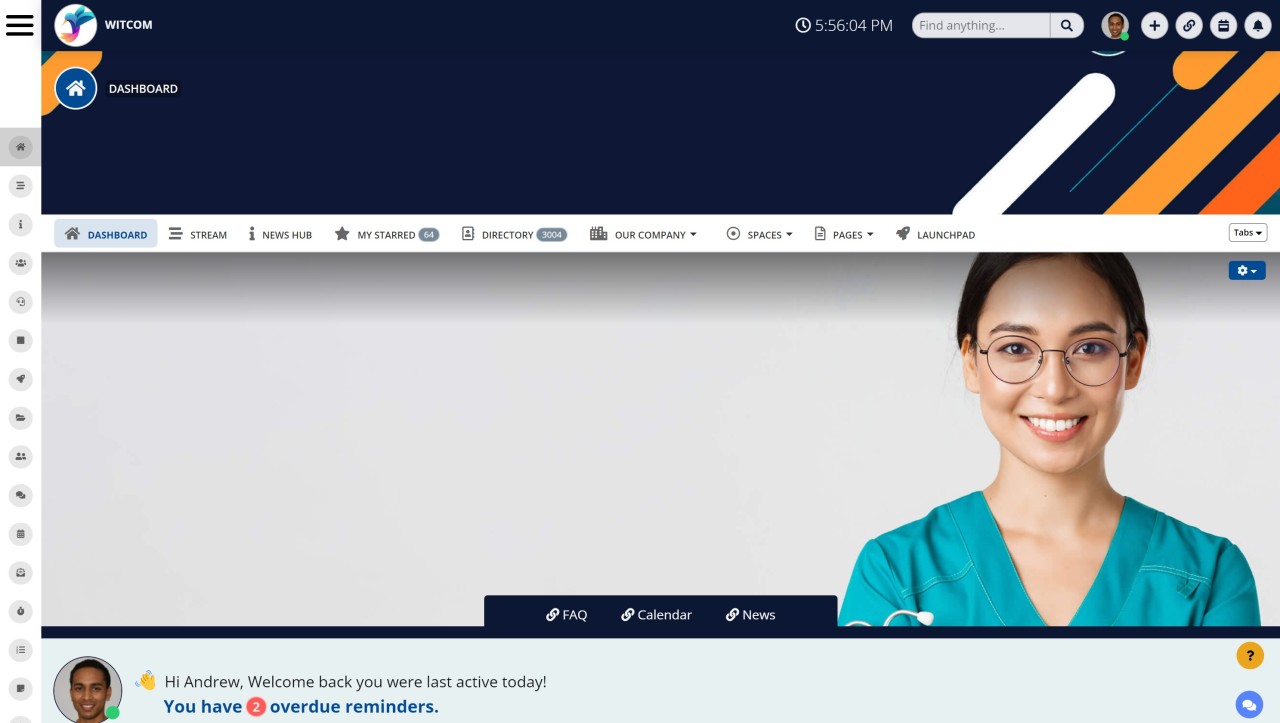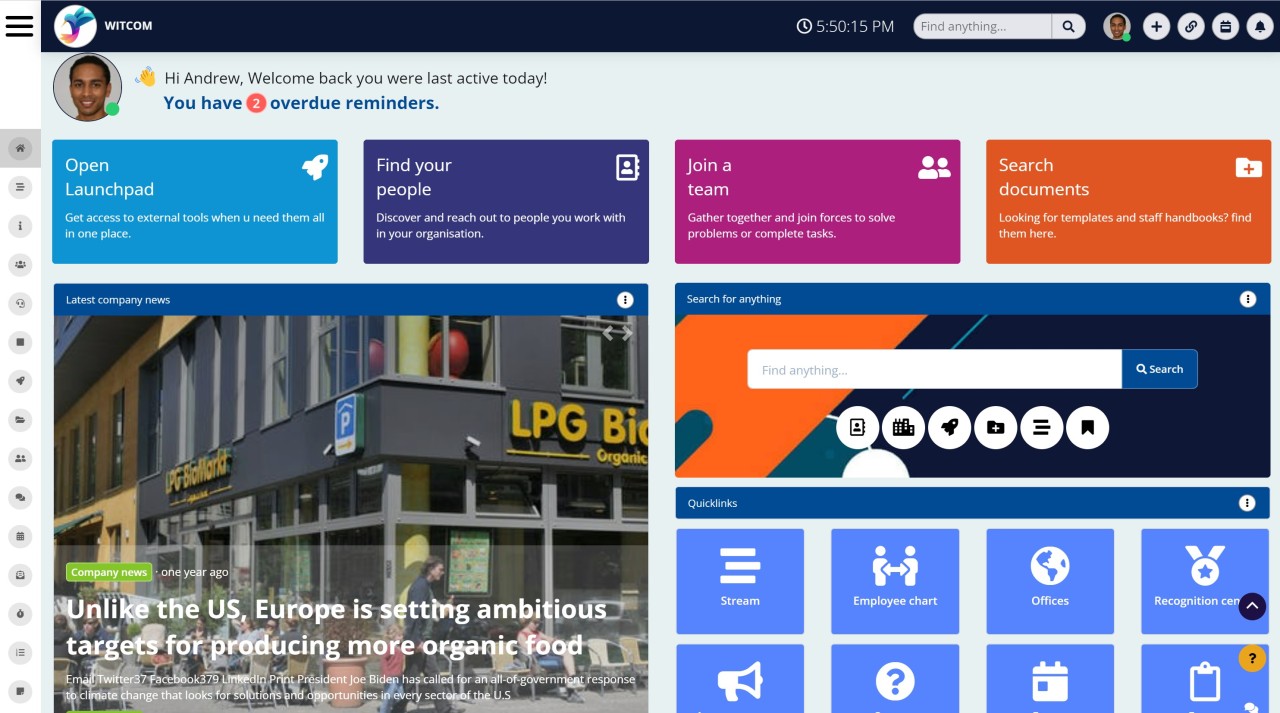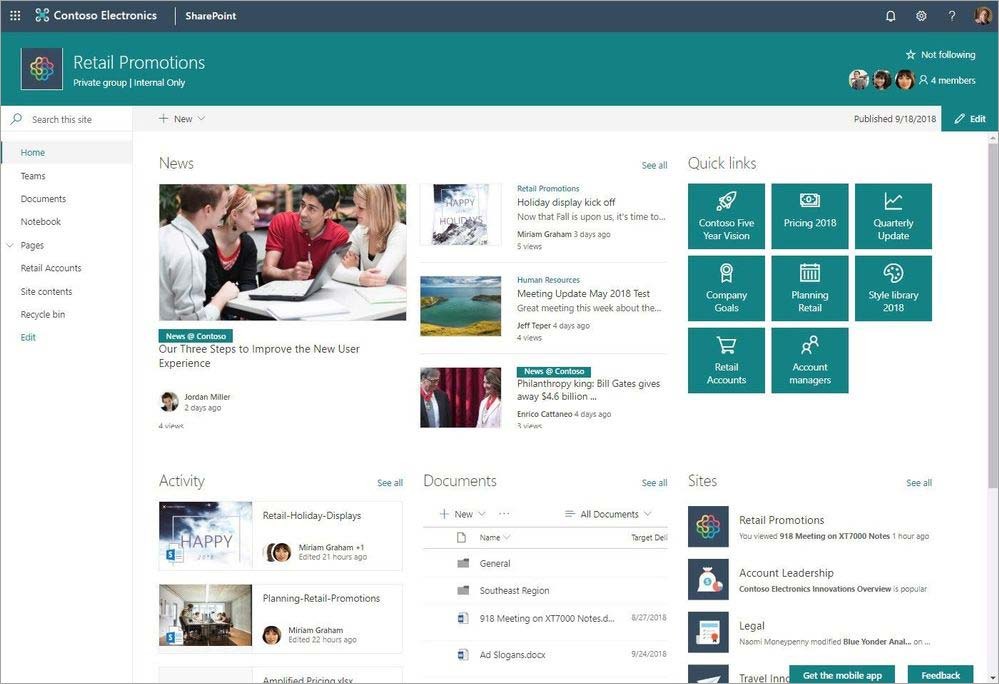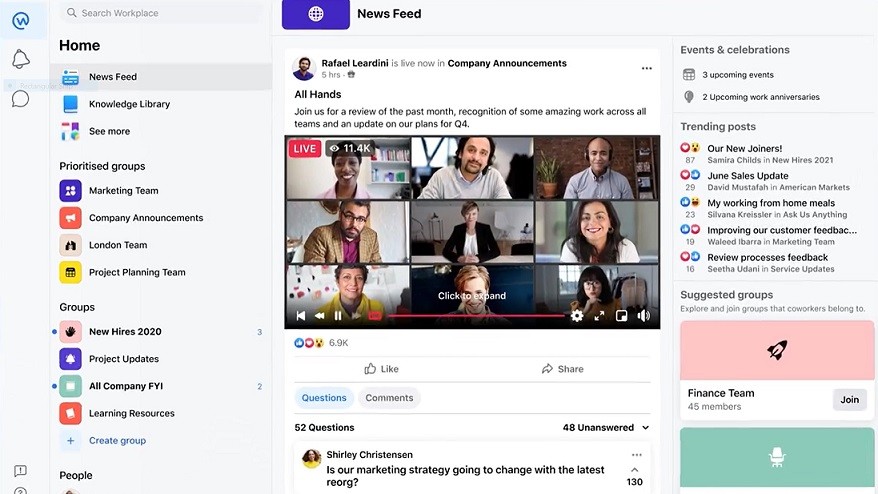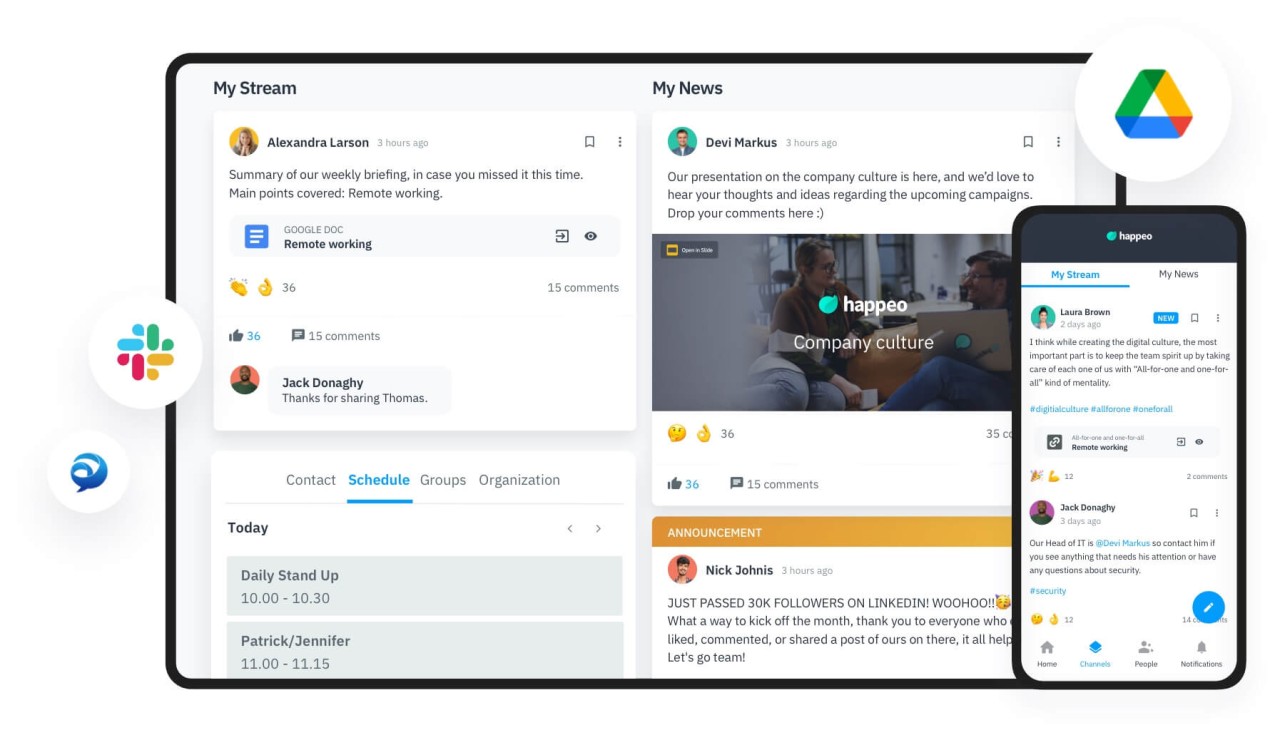Insight Blog
Agility’s perspectives on transforming the employee's experience throughout remote transformation using connected enterprise tools.
25 minutes reading time
(5013 words)
Exploring Enterprise Intranet: The Ultimate Guide to Enhancing Communication and Collaboration
Explore the ultimate guide on enterprise intranet to boost communication, collaboration, and employee engagement in your organization.
In today's digital workplace, effective communication and collaboration are essential for the success of any enterprise. This is where enterprise intranets come into play, providing a centralized platform for sharing information and enabling people to work together more efficiently. In this ultimate guide to enhancing communication and collaboration, we will explore the importance of enterprise intranet and its role in supporting a company's mission.
Key takeaways
- Enterprise intranets streamline communication, foster collaboration, and support company missions.
- Modern intranet solutions enable remote working and enhance overall employee productivity.
- Mobile intranets and integrated communication tools drive collaboration in the digital workplace.
- Social features in intranets boost employee engagement and connect internal communicators.
- Cloud-based intranets offer scalability, flexibility, and improved security for businesses.
- Successful intranet implementation involves strategic planning, overcoming challenges, and measuring ROI.
What is an enterprise intranet?
An enterprise intranet is a private network that is accessible only to an organization's employees, contractors, and partners. It provides a centralized platform for sharing information, communicating with remote teams, and collaborating on projects. Intranet solutions are designed to cater to the needs of modern businesses by providing a secure and reliable platform for employees to access company information and resources.
The role of enterprise intranet in a digital workplace
As organizations continue to embrace digital technologies, enterprise intranet plays an increasingly important role in creating a digital workplace. Whether you're launching a new intranet platform, naming an internal project, or branding a digital workspace, using a business name generator can help you brainstorm memorable and relevant names that align with your company culture and vision. A digital workplace is a virtual environment that enables employees to work from anywhere, using any device, and access the information and resources they need to be productive.
Here is how an enterprise intranet can be used in a digital workplace:
1. Centralized platform for sharing information and collaboration
- Provides a platform for remote and distributed teams to communicate effectively
- Ensures everyone has access to the latest information and is on the same page
- Modern enterprise social intranet solutions with social features cater to remote working and mobile device usage
2. Secure and reliable platform for accessing company information and resources
- Provides easy access to company policies, procedures, employee benefits, and training materials
- Improves employee engagement and ensures everyone is working towards the same goals
3. Scalable, flexible, and secure access to company information and resources
- Cloud-based intranets are particularly well-suited for digital workplaces
- Organizations can easily add new features and functionality as their needs evolve
4. Streamlining business processes and improving operational efficiency
- Provides a centralized platform for sharing information and collaborating on projects
- Reduces duplication of effort and improves the accuracy and completeness of data
- Leads to better decision-making, improved customer service, and increased productivity
By leveraging the benefits of enterprise intranet solutions, organizations can build a more productive and engaged workforce, streamline business processes, and achieve their business goals in the digital workplace.
How an enterprise intranet can support a company's mission?
Enterprise intranet solutions support a company's mission by providing a centralized communication, collaboration, and knowledge-sharing platform. In today's fast-paced and digital work environment, intranet solutions help organizations connect employees with the company's mission, vision, and values. It enables employees to work together more effectively toward the company's mission.
Moreover, intranet solutions streamline business processes, reduce duplication of effort, and improve the accuracy and completeness of data. Organizations can make better decisions, provide better customer service, and increase productivity by providing a centralized platform for sharing information and collaborating on projects.
Cloud-based enterprise intranets are particularly well-suited for scaling businesses. These solutions provide a flexible and secure platform for employees to access company information and resources from any device, anywhere, and anytime.The Shift to Remote Working and the Need for Enterprise Intranet Solutions
The global pandemic has brought a paradigm shift to the way we work, with remote working becoming the new normal. The rise of remote working has presented both challenges and opportunities for organizations and their employees.
The rise of remote working
Remote working has become increasingly popular over the years, but it was the COVID-19 pandemic that accelerated its adoption. With lockdowns and social distancing measures in place, organizations had to adapt to the new normal and embrace remote working to keep their businesses running. According to a recent report by Gartner, 88% of organizations worldwide have encouraged or required employees to work from home due to the pandemic.
Challenges faced by organizations and employees
The shift to remote working has not been without its challenges. For organizations, one of the main challenges has been maintaining effective communication and collaboration among remote teams. With employees working from different locations and time zones, it can be challenging to keep everyone on the same page and ensure that important information is shared in a timely manner.
Employees, on the other hand, face challenges such as social isolation, lack of work-life balance, and difficulty in separating work from home life. They also face challenges related to accessing company information and resources, especially when they are not physically present in the office.
How do enterprise intranet solutions improve communications and enable people to work remotely?
Enterprise intranet solutions can help organizations overcome remote working challenges and enable their employees to work more effectively from home. Intranet solutions provide a centralized platform for sharing information, communicating with remote teams, and collaborating on projects.
Modern social intranet solutions are designed to cater to remote working and mobile device usage. They come equipped with social features that enable employees to connect with each other, share information, and collaborate on projects in real time. These solutions also provide employees with easy access to company information and resources, regardless of their physical location.
Communication and Collaboration Tools in Modern Enterprise Intranets
Modern enterprise intranets are equipped with various communication and collaboration tools essential for effective teamwork and productivity.
Now, will provide an overview of the communication and collaboration tools available in modern intranet solutions and discuss their importance.
Overview of Communication Tools
Communication tools such as instant messaging, video conferencing, and email are essential for effective collaboration in modern workplaces. Modern enterprise social intranet solutions with social features also include social media-style communication tools that allow employees to connect with each other and share information in real time.
In addition, modern intranet solutions offer features such as discussion forums, blogs, and wikis that allow employees to collaborate on projects and share knowledge. These tools help employees work together more effectively, share best practices, and learn from each other.
Collaboration Tools and Their Importance
Collaboration tools such as project management, task lists, and team calendars are essential for organizing work and ensuring that everyone is on the same page. With these tools, employees can track their progress, assign tasks to team members, and monitor deadlines.
Modern intranet solutions also include document management and version control tools that ensure that everyone is working with the most up-to-date information. These tools help reduce the risk of errors and inconsistencies in data.
Moreover, collaboration tools foster a sense of accountability and ownership among employees. When employees are responsible for specific tasks, they feel more invested in the outcome and are more likely to take ownership of their work.
Mobile Intranet and the Benefits of a Mobile Device-Ready Solution
With the rise of mobile devices, it's essential for intranet solutions to be mobile device-ready. Mobile intranet solutions enable employees to access company information and resources from any location, using any device. This allows employees to work remotely and stay connected with their colleagues and the company's mission.
Modern mobile intranet solutions also offer features such as mobile task lists, mobile calendars, and mobile collaboration tools that enable employees to work on the go. These tools help employees stay productive and engaged, regardless of their physical location.
Furthermore, mobile intranet solutions can help organizations reduce costs and increase efficiency. Organizations can reduce overhead costs and improve operational efficiency by enabling employees to work remotely.
Social Features and Employee Engagement in Enterprise Intranets
Enterprise intranets with social features are becoming increasingly popular as organizations recognize the importance of employee engagement and collaboration. In this section, we'll explore the role of social intranets in enhancing employee engagement, the integration of social media in intranet software, and modern social features that drive internal communicators.
The Role of Social Intranets in Enhancing Employee Engagement
Social intranets play a critical role in enhancing employee engagement by providing a platform for employees to connect and collaborate with each other. These intranets enable employees to share information, exchange ideas, and work together on projects.
Moreover, social intranets foster a sense of community and collaboration among employees, which can lead to improved job satisfaction and retention. When employees feel connected to their colleagues and the company's mission, they are more likely to be engaged and motivated in their work.
The Integration of Social Media in Enterprise Intranet Software
Modern intranet software often includes integration with social media platforms such as LinkedIn, Twitter, and Facebook. This integration enables employees to share information and connect with colleagues across the organization and beyond.
By integrating social media into enterprise intranets, organizations can improve their brand awareness and reach a wider audience. Employees can also use social media to promote their skills and experience, which can lead to new opportunities and career growth.
Modern Social Features that Drive Internal Communicators
Modern social features that drive internal communicators include things like discussion forums, blogs, and wikis that allow employees to collaborate on projects and share knowledge. These features enable employees to work together more effectively, share best practices, and learn from each other.
Moreover, modern social features also include features like gamification and recognition programs that incentivize employees to achieve their goals and recognize their accomplishments. Employees who feel valued and appreciated are more likely to be engaged and motivated in their work.
Sharing Information and Knowledge Management in Enterprise Intranets
Effective information sharing and knowledge management are critical components of a successful digital workplace. In this section, we'll explore the importance of information sharing in a digital workplace, how intranet solutions facilitate sharing information among employees, and best practices for efficient knowledge management.
The Importance of Information Sharing in a Digital Workplace
Information sharing is essential for effective collaboration and decision-making in a digital workplace. With the rise of remote working and distributed teams, employees need to have access to the latest information and be on the same page.
In addition, effective information sharing can lead to increased innovation and creativity in the workplace. When employees share their ideas and knowledge, they can build on each other's work and develop new and innovative solutions to business problems.
How Intranet Solutions Facilitate Sharing Information Among Employees
Enterprise intranets provide a centralized platform for sharing information among employees. Intranet solutions enable employees to access company policies, procedures, employee benefits, and training materials from a single location.
Moreover, modern intranet solutions also include features such as discussion forums, blogs, and wikis that allow employees to collaborate on projects and share knowledge. These features enable employees to work together more effectively, share best practices, and learn from each other.
Best Practices for Efficient Knowledge Management
Efficient knowledge management is essential for maximizing the benefits of information sharing in a digital workplace. Here are some best practices for efficient knowledge management:
- Establish clear ownership and responsibility for knowledge management
- Develop a centralized repository for storing and accessing knowledge
- Encourage employees to share their knowledge and ideas
- Develop a system for capturing and storing tacit knowledge
- Use analytics to measure the effectiveness of knowledge management efforts
By following these best practices, organizations can ensure that their knowledge management efforts are effective and that their employees can access the information they need to succeed.
Cloud-Based Enterprise Intranets and Scalability
Cloud-based enterprise intranets are becoming increasingly popular as organizations recognize the benefits of scalability and flexibility. In this section, we'll explore the benefits of cloud-based intranets, security considerations for cloud-based solutions, and the scalability and flexibility of cloud-based intranets.
The Benefits of Cloud-Based Enterprise Intranets
Cloud-based enterprise intranet solutions offer a range of benefits for organizations. The flexibility of cloud-based intranets enables employees to access information from any device, anywhere, and at any time, making them ideal for remote working and distributed teams.
Additionally, the scalability of cloud-based intranets means that they can easily adjust to changes in workforce size or business needs, without the need for expensive hardware and maintenance costs.
Another significant benefit of cloud-based intranets is cost savings. Organizations can reduce their IT costs and allocate resources more effectively by eliminating the need for expensive hardware and maintenance costs associated with on-premise solutions. Finally, cloud-based intranets receive automatic updates, ensuring that they are always up-to-date and secure, freeing up resources for other tasks.
Security Considerations for Cloud-Based Solutions
Security is a critical consideration for cloud-based intranets, and organizations must ensure their data is protected. Organizations should follow some best practices to ensure the security of their cloud-based solutions.
Using strong authentication and access controls is essential for protecting data. By using robust authentication mechanisms and access controls, organizations can ensure that only authorized users have access to sensitive data.
Encryption is another important security measure for protecting data in transit and at rest. By encrypting data, organizations can ensure that data is not intercepted or accessed by unauthorized users.
Regularly monitoring and auditing access to data is essential for identifying and addressing security threats. Organizations should monitor and audit access to data to ensure that only authorized users are accessing data.
Finally, organizations should ensure that data is backed up and can be restored in case of a disaster. By regularly backing up data, organizations can ensure that they can quickly recover from data loss or corruption.
Scalability and Flexibility of Cloud-Based Intranets
One of the key benefits of cloud-based enterprise intranets is their scalability and flexibility. Cloud-based intranets can easily scale up or down to accommodate changes in workforce size or business needs. In order to properly develop your business, you will also need the best website builder that will perfectly suit your needs.
Moreover, cloud-based enterprise intranets can be customized to meet the specific needs of organizations. Many modern solutions now incorporate flexible design systems, such as enterprise IT with Tailwind, allowing companies to tailor their platforms more efficiently while improving communication, collaboration, and overall productivity.
Comparison of Top Enterprise Intranets
Choosing the right enterprise intranet solution can be challenging. With so many options available, knowing which solution best suits your organization can be difficult. In this section, we'll provide an overview of the comparison criteria and compare some of the top enterprise intranets available on the market.
Comparison Criteria for Enterprise Intranet
We have considered several criteria to compare enterprise intranets, including features and benefits, pricing, and user experience. By evaluating intranets based on these criteria, we can identify the best solution for your organization.
AgilityPortal
Agilityportal is an enterprise intranet solution offering various features and benefits, including document management, employee engagement tools, mobile intranet, and social features. The software is designed to help organizations improve communication and collaboration among employees and teams. It is one of the best enterprise intranet software.
Its user-friendly interface makes it easy to use, and its customizable features allow organizations to tailor the software to their specific needs.
Agilityportal pricing starts at $5 per user per month, making it an affordable option for small and medium-sized businesses.
Microsoft SharePoint
Microsoft SharePoint is a robust intranet platform that empowers teamwork, enhances knowledge management, and enables seamless collaboration across your organization. With its extensive range of features, Microsoft SharePoint allows you to share and manage content, knowledge, and applications easily. The platform has been designed to quickly find information and provide an efficient way for teams to collaborate on projects.
In terms of pricing, Microsoft SharePoint is an affordable option, with pricing starting at $5 per user per month if paid annually. However, if you require the full range of features, the enterprise version is available at $10 per user per month.
Workplace from Meta
Workplace intranet by Meta. Looking for an intranet platform that feels familiar and user-friendly? Workplace by Meta (previously Facebook) may be the ideal solution for your company. This business communication tool helps teams stay connected by providing a range of features, including Live Video and Groups, that users are already familiar with. It is good for global enterprises as it can work as an enterprise social network.
Workplace's user-friendly interface, combined with its familiar Meta-like features and functionalities, make it easy for your team to start using right away. With Workplace, your team can share information, collaborate, and connect with their peers effortlessly.
Pricing for Workplace is affordable, starting at just $4 per user per month for the basic plan. For larger organizations, enhanced admin and support features and streaming for larger audiences are also available as add-ons.
Happeo
Looking for a powerful and comprehensive intranet solution? Look no further than Happeo. This intranet platform offers a range of features and functionalities, including a robust Federated search function that makes it one of the best on the market. It is one of the best modern intranets.
One of Happeo's strengths is its integration with G Suite, which provides users with an enhanced content management experience. Additionally, Happeo offers a range of employee engagement tools that help keep your team motivated and engaged.
Pricing for Happeo is available through direct contact with the seller, with three pricing plans available. While pricing is not listed on their website, Happeo's pricing is affordable and can be tailored to fit the needs of your organization.
Thus, choosing the right enterprise intranet solution is critical to the success of your organization. By evaluating intranets based on features and benefits, pricing, and user experience, you can identify the best solution for your organization. The intranets we've compared in this section are among the top solutions available on the market and are worth considering for your organization.
Choosing the Right Enterprise Intranet for Your Business
In today's digital age, having an enterprise intranet is crucial for businesses to stay competitive and efficient. However, choosing the right intranet solution for your organization can be a daunting task. To help you make the right choice, here are some key factors to consider:
Assessing Your Business Needs
Before selecting an enterprise intranet, assessing your business needs is important. Consider factors such as your organization's size, workflow, and employees' work styles. Understanding your business needs will help you choose an intranet solution that meets your specific requirements.
Evaluating Features and Compatibility
Once you have assessed your business needs, evaluate the features and compatibility of each intranet solution. Look for solutions that offer the features you need, such as document management, collaboration tools, and social features. Ensure that the intranet solution is compatible with your existing systems and software.
Considering Pricing and Scalability
Pricing is an important consideration when choosing an enterprise intranet. Look for a solution that offers affordable pricing plans that fit your budget. Additionally, consider the scalability of the solution to ensure that it can accommodate your business growth in the future.
Importance of User Experience and Support
User experience and support are critical factors to consider when selecting an enterprise intranet. Look for solutions that offer an intuitive and user-friendly interface that will be easy for your employees to use. Additionally, choose a solution that offers reliable and responsive support to ensure that any issues are quickly resolved.
Overall, choosing the right enterprise intranet for your business is a process that requires careful consideration of your organization's unique needs. By assessing your business needs, evaluating features and compatibility, considering pricing and scalability, and prioritizing user experience and support, you can select an intranet solution that will enhance productivity, collaboration, and communication within your organization.
Implementing an Enterprise Intranet Solution
Implementing an effective enterprise intranet solution is crucial for businesses to stay competitive. An enterprise intranet can improve employee communications and collaboration, streamline processes, and provide a centralized platform for sharing information. This article will outline the steps to successful implementation, overcoming challenges, and measuring success and ROI.
Steps to successful implementation:
- Define your objectives: Begin by establishing clear goals for your intranet implementation. Consider your company's mission, overall business strategy, and how the intranet can support them. This will provide a strong foundation and ensure that the intranet aligns with the organization's priorities.
- Choose the right enterprise intranet software: Research and evaluate various intranet solutions to find the one that best meets your needs. Consider factors like ease of use, scalability, customization options, communications tools, and social features. Opt for cloud-based intranets if you require flexibility and remote accessibility.
- Create a project plan: Develop a detailed project plan that outlines the implementation timeline, budget, and resources needed. Assign a dedicated project manager to oversee the process and ensure that the project stays on track.
- Engage internal communicators: Work closely with key stakeholders, such as managers and department heads, to gather input on the intranet's design and functionality. This will help ensure that the intranet meets the needs of all users and fosters a sense of ownership.
- Design a user-friendly interface: Prioritize the user experience by designing an intuitive and visually appealing interface. Incorporate mobile device compatibility to enable employees to access the intranet from anywhere, supporting remote working and boosting productivity.
- Integrate communication and collaboration tools: Equip the intranet with a range of communications tools to facilitate seamless collaboration among employees. These may include instant messaging, video conferencing, file sharing, and project management features.
- Launch and promote the intranet: Announce the intranet's launch with a comprehensive communication campaign to generate excitement and encourage adoption. Provide employees with training and resources to help them understand the platform's features and benefits.
Overcoming challenges:
- Encourage adoption: Drive user adoption by highlighting the benefits of the intranet, such as improved communication and collaboration and easier access to information. Offer training and support to ensure employees feel comfortable using the platform.
- Foster employee engagement: Create an engaging intranet experience by incorporating modern social elements, such as social media integration, discussion forums, and interactive content. This will encourage employees to participate and interact with the platform.
- Address security concerns: Implement robust security measures to protect sensitive company information and maintain user trust. This includes secure authentication methods, data encryption, and regular security audits.
- Monitor and optimize performance: Regularly review the intranet's performance and user feedback to identify areas for improvement. Make necessary adjustments to ensure the platform remains relevant, efficient, and user-friendly.
Measuring success and ROI
- Define key performance indicators (KPIs): Establish KPIs to measure the intranet's success, such as user adoption rates, employee satisfaction, and improvements in communication and collaboration.
- Measure employee engagement: Track engagement metrics like the number of active users, content interactions, and time spent on the intranet. Analyze this data to determine if the intranet effectively promotes employee engagement and facilitates communication.
- Assess the impact on productivity: Evaluate the intranet's impact on employee productivity by comparing pre and post-implementation performance metrics. This may include a reduction in time spent searching for information, improvements in project collaboration, and quicker decision-making processes.
- Calculate ROI: Determine your enterprise intranet's return on investment (ROI) by comparing implementation and maintenance costs with the financial benefits gained. These benefits may include increased productivity, reduced operational costs, and more efficient use of resources.
- Monitor user feedback: Regularly solicit user feedback to gain insights into the intranet's effectiveness and identify areas for improvement. This will help ensure the platform continues to meet the needs of employees and supports the organization's objectives.
- Thus, implementing a successful enterprise intranet solution requires careful planning, collaboration, and ongoing evaluation. By following the steps outlined in this article, organizations can overcome challenges and measure the success and ROI of their intranet. A well-designed and optimized intranet will enable people to work more effectively, support remote working, and contribute to a thriving digital workplace.
The future of enterprise intranets and the digital workplace
The future of enterprise intranets and the digital workplace is poised for rapid transformation, driven by advancements in technology and evolving work practices. As organizations increasingly embrace remote working and geographically dispersed teams, the need for robust communication and collaboration tools will continue to grow.
In the coming years, enterprise intranet solutions will likely become more agile, adaptive, and focused on enhancing user experience. The integration of modern social elements, such as social media, gamification, and immersive technologies like augmented and virtual reality, will further promote employee engagement and connection.
The rise of mobile intranets is also expected to continue, as more organizations recognize the need to enable people to access information and collaborate from any mobile device. This shift will help improve communications, streamline workflows, and contribute to a more productive and inclusive digital workplace.
Cloud-based intranets will become increasingly popular, offering scalability, cost-effectiveness, and seamless integration with existing systems. These solutions will empower internal communicators to create more personalized and context-aware content, strengthening alignment with the company's mission and fostering a sense of belonging among employees.
Wrapping Up
Implementing an effective enterprise intranet is essential for modern businesses striving to enhance communication and collaboration within their organizations. An enterprise intranet can significantly improve communications and promote a more productive digital workplace by offering a centralized platform for sharing information and integrating essential communications tools.
In today's world, where remote working is becoming increasingly common, a mobile-friendly intranet that supports a mobile intranet experience is vital to enable people to stay connected and engaged from any location. Integrating social features and modern social elements, such as social media and interactive content, can boost employee engagement and foster a sense of belonging among team members.
Internal communicators play a crucial role in aligning employees with the company's mission and should be actively involved in developing and managing the intranet. With the availability of numerous intranet solutions and intranet software options, organizations can choose from a range of cloud-based intranets and other solutions to meet their specific needs.
Ultimately, a well-designed and strategically implemented enterprise intranet is the key to unlocking the full potential of your organization's communication and collaboration capabilities, positioning your business for long-term success in the competitive global marketplace.
Frequently Asked Questions About Enterprise Intranet
What is an enterprise intranet, and why is it important for modern businesses?
An enterprise intranet is a private network within a company, designed to facilitate communication and collaboration among employees. It is important for modern businesses because it streamlines workflows, fosters employee engagement, and supports remote working.
Which routing device connects the enterprise's intranet to the internet?
A router connects the enterprise's intranet to the internet, enabling secure data transfer and communication between internal and external networks.
Why does your business need a next-generation enterprise intranet?
A next-generation enterprise intranet enhances collaboration, embraces modern social elements, and integrates seamlessly with communication tools. It supports mobile device access, helping businesses adapt to evolving work practices and stay competitive.
How can an enterprise intranet improve communication and collaboration within a company?
An enterprise intranet centralizes information, connects dispersed teams, and integrates various communication tools, fostering a digital workplace that encourages seamless collaboration and effective communication.
What are some of the best communication tools that can be integrated into an enterprise intranet?
Instant messaging, video conferencing, file sharing, project management, and discussion forums are some of the best communication tools that can be integrated into an enterprise intranet.
How can a mobile intranet solution help remote workers stay connected and engaged with their colleagues?
A mobile intranet allows remote workers to access information, communicate, and collaborate from any location using their mobile devices. This connectivity enhances productivity and maintains a sense of belonging within the organization.
What social features should be included in an enterprise intranet to encourage employee engagement and communication?
An enterprise intranet can include features like discussion forums, social media integration, and interactive content to foster employee engagement and open communication.
What role does internal communication play in a company's mission, and how can intranet software support this?
Internal communication aligns employees with the company's mission and fosters a shared sense of purpose. Intranet software supports this by providing a platform for sharing information, celebrating successes, and reinforcing company values.
What are the benefits of using cloud-based intranets for communication and collaboration?
Cloud-based intranets offer scalability, cost-effectiveness, remote accessibility, and seamless integration with existing systems, making them ideal for facilitating organizational communication and collaboration.
What are the key features to look for in intranet software that can help improve communication and collaboration?
Key features to look for in intranet software include user-friendly interfaces, mobile compatibility, integration with communication tools, customization options, and robust security measures.
What is a digital workplace, and how can an enterprise intranet support it?
A digital workplace is a virtual environment where employees can access the tools, resources, and information they need to perform their jobs effectively. An enterprise intranet supports the digital workplace by centralizing communication, fostering collaboration, enabling remote working, and integrating with essential tools and applications, thereby creating a connected and productive work environment.
Categories
Blog
(2656)
Business Management
(325)
Employee Engagement
(213)
Digital Transformation
(178)
Growth
(122)
Intranets
(120)
Remote Work
(61)
Sales
(48)
Collaboration
(38)
Culture
(29)
Project management
(29)
Customer Experience
(26)
Knowledge Management
(21)
Leadership
(20)
Comparisons
(6)
News
(1)
Ready to learn more? 👍
One platform to optimize, manage and track all of your teams. Your new digital workplace is a click away. 🚀
Free for 14 days, no credit card required.



